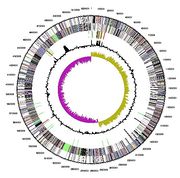Clostridium cellulovorans: Difference between revisions
| Line 30: | Line 30: | ||
==References== | ==References== | ||
[http://www.ncbi.nlm.nih.gov/pmc/articles/PMC240319/ (1) Sleat, R., Mah, R. A. & Robinson, R. Isolation and Characterization of an Anaerobic, Cellulolytic Bacterium, Clostridium- | [http://www.ncbi.nlm.nih.gov/pmc/articles/PMC240319/ (1) Sleat, R., Mah, R. A. & Robinson, R. "Isolation and Characterization of an Anaerobic, Cellulolytic Bacterium, ''Clostridium-cellulovorans'' Sp-Nov". ''Applied Environmental Microbiology''.1984. Volume 48. p. 88-93 ].<Br> | ||
2 Himmel, M. E., Ruth, M. F. & Wyman, C. E. Cellulase for commodity products from cellulosic biomass. Curr Opin Biotech 10, 358-364 (1999). | 2 Himmel, M. E., Ruth, M. F. & Wyman, C. E. Cellulase for commodity products from cellulosic biomass. Curr Opin Biotech 10, 358-364 (1999). | ||
3 Tamaru, Y. et al. Genome Sequence of the Cellulosome-Producing Mesophilic Organism Clostridium cellulovorans 743B. J Bacteriol 192, 901-902 (2010). | 3 Tamaru, Y. et al. Genome Sequence of the Cellulosome-Producing Mesophilic Organism Clostridium cellulovorans 743B. J Bacteriol 192, 901-902 (2010). | ||
Revision as of 00:18, 20 April 2011
Classification
• Kingdom - Bacteria
• Phylum - Firmicutes
• Class - Clostridia
• Order - Clostridiales
• Family - Clostridiaceae
• Genus - Clostridium
Species
Clostridium cellulovorans
Other name: Clostridium cellulovorans strain 743B
Description and Significance
Clostridium cellulovorans (ATCC 35296) is anaerobic, spore forming and stain gram negative non-motile rods originally isolated from a batch methanogenic fermentation of hybrid poplar wood. C. Cellulovorans is a mesophilic bacterium with optimum growth temperature of 37°C, though it can grow in a temperature range of 20 to 40°C. Optimum pH is 7.0, and the pH range of growth is 6.4 to 7.8. This organism produces extracellular enzyme complex known as cellulosome, which can degrade plant cell walls. As most abundantly available potential source of fermentable sugars in the world are the higher plants’ cell walls, utilization of such a vast resource for energy production would reduce the dependency on non-renewable fossil fuel. Hence, C. cellulovorans have potential industrial application for energy production.
Genome Structure
Genome sequencing of C. cellulovorans has been completed. C. Cellulovorans contains circular chromosome containing 5,123,527 bp genomes which is about 1 Mbp larger than the genomes from other cellulosomal clostridia; 57 cellulosomal genes were reported in C. Cellulovorans. Number of predicted genes was the largest in C. cellulovorans as compared to other cellulosomal clostridia. C. Cellulovorans contains large number of genes encoding non-cellulosomal enzymes which are more associated with polysaccharides (such as hemicelluloses and pectins) degradation than to cellulose. Scientists have found two novel genes encoding scaffolding proteins in C. cellulovorans genome
Cell Structure, Metabolism and Life Cycle
C. Cellulovorans are 0.7 to 0.9 by 2.5 to 3.5 µm in size and are non-motile rods, though peritrichous flagella were detected under electron microscopy. Both spores and vegetative colonies of C. Cellulovorans are irregular, containing opaque edge and a center devoid. Spores are oblong that occur either centrally or subterminally within the mature sporangium. It produces plant cell wall degrading extracellular multienzyme complex called cellulosome. When grown in cellulose, C. cellulovorans forms ultrastructural protuberances, which may be aggregation of smaller cellulosome complexes, also known as polycellulosomes.
Cellulosomal components synergistically interact to catalyze the degradation of cellulose and hence, cellulosome acts as a macromolecular machine. Apart from cellulose, C. cellulovorans ferments various carbon sources, such as xylan, pectin, cellobiose, glucose, fructose, galactose, sucrose, lactose and mannose and the fermentation products are hydrogen, carbon dioxide, acetate, butyrate, formate and lactate.
Ecology and Pathogenesis
Clostridium Cellulovorans is non pathogenic to human beings.
References
(1) Sleat, R., Mah, R. A. & Robinson, R. "Isolation and Characterization of an Anaerobic, Cellulolytic Bacterium, Clostridium-cellulovorans Sp-Nov". Applied Environmental Microbiology.1984. Volume 48. p. 88-93 .
2 Himmel, M. E., Ruth, M. F. & Wyman, C. E. Cellulase for commodity products from cellulosic biomass. Curr Opin Biotech 10, 358-364 (1999).
3 Tamaru, Y. et al. Genome Sequence of the Cellulosome-Producing Mesophilic Organism Clostridium cellulovorans 743B. J Bacteriol 192, 901-902 (2010).
4 Tamaru, Y., Miyake, H., Kuroda, K., Ueda, M. & Doi, R. H. Comparative genomics of the mesophilic cellulosome-producing Clostridium cellulovorans and its application to biofuel production via consolidated bioprocessing. Environ Technol 31, 889-903 (2010).
5 Tamaru, Y. & Doi, P. H. Pectate lyase A, an enzymatic subunit of the Clostridium cellulovorans cellulosome. P Natl Acad Sci USA 98, 4125-4129 (2001).
6 Bayer, E. A., Shimon, L. J. W., Shoham, Y. & Lamed, R. Cellulosomes - Structure and ultrastructure. J Struct Biol 124, 221-234 (1998).
Author
Page authored by Umesh Adhikari and Joe Araiz, student of Prof. Jay Lennon at Michigan State University.



